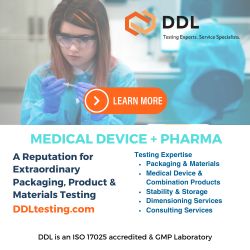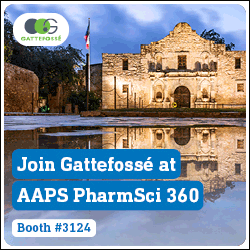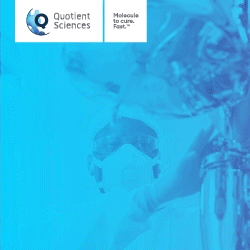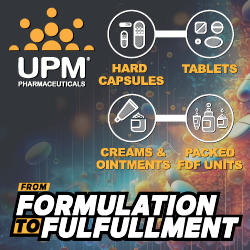Issue:October 2024
CONTROLLED RELEASE - How Advanced Excipient Knowledge is Shaping the Future of Controlled-Release Formulations
INTRODUCTION
Controlled-release (CR) formulations, like extended-release (ER) and sustained-release (SR) tablets, are reshaping drug delivery across the pharmaceutical industry. This is because they offer significant advantages over immediate-release tablets, capsules, and liquid delivery formats, including improved therapeutic outcomes, less-frequent dosing for greater patient convenience, better safety profiles, and reduced side effects, all of which enhance adherence to treatment and thus patient compliance.1
For these reasons, CR dosage forms represent one of the fastest growing types of delivery systems. This is illustrated by the expected expansion of the global CR excipients market, which has an annual growth rate projection of 8.5% until 2030.2,3 CR delivery shows particular promise in therapeutic fields where precise release profiles are necessary for safe, long-term treatment of conditions, such as epilepsy, diabetes, hypertension, and chronic pain management.4,5 However, the next generation of CR pharmaceuticals demand even more from functional excipients to address the increasing complexity of delivery system performance. Thus, further advancements in the space hinge on excipient technology and expertise keeping pace.
The following reviews the latest insights behind CR formulations using hydroxypropyl methylcellulose (HPMC) excipients – highlighting the impact of excipient properties on CR performance. It also elaborates on how HPMC substitution specifically can assist formulators in developing cutting-edge CR delivery systems with differentiated performance.
EXCIPIENTS ARE THE KEY TO SUCCESS IN CR FORMULATIONS
While CR drug delivery is a game-changer for pharmaceutical companies and patients alike, there are some challenges associated with formulation development. Designing CR formulations can be a complex, time-consuming, and costly process, for instance.6 Specifically, manufacturers need to carefully consider the potential risk of release deviation, which can occur if the CR formulation is not optimally designed.6 To avoid cost implications and drug safety concerns, the creation of robust CR drug delivery systems is paramount.
This can be achieved by selecting the right polymeric excipient to meet CR targets. Functional excipients play a key role in CR formats as they help modulate release of the active pharmaceutical ingredient (API). Many innovative CR formulations – like hydrophilic matrix tablets – use high molecular weight, water-soluble cellulose ethers, like HPMC (also known as hypromellose), to attain CR performance. But given the variety of HPMC (and other excipient) options, how do formulators choose the most suitable HPMC type or grade to accomplish the desired release performance targets?
Selection begins with understanding how the characteristics of polymeric excipients influence drug release. Here, we share the fundamental intricacies of excipient chemistry and offer guidance for achieving optimally performing CR matrix tablets.
FORMATION OF A GEL LAYER IS IMPORTANT FOR CR PERFORMANCE
Hydrophilic matrix tablets control API release via formation of an enveloping hydrogel or swollen layer (Figure 1).7 This hydrogel layer forms when liquid contacts the surface of the tablet and encounters the CR excipient. In the case of HPMC, the particles – which should be uniformly distributed throughout the matrix tablet to guarantee good CR performance – start to hydrate, swell, and coalesce with other HPMC particles in close proximity. This action creates a contiguous swollen polymer (hydrogel) layer around the core of the tablet.

Once formed, the swollen hydrogel layer controls API release through a combined mechanism of (1) diffusion of dissolved API through the hydrogel and (2) erosion of the hydrogel. This dual mechanism accommodates the release of APIs of varying solubility. For example, more soluble APIs are typically released through diffusion-dominated mechanisms, whereas less- soluble APIs depend more on erosion of the hydrogel layer. In general, though, when the hydrogel layer first develops, a small portion of the API dose near the tablet surface is liberated. Once the enveloping hydrogel forms, the majority of the API dose is then gradually released over an extended period. This explains why hydrophilic matrix tablets commonly exhibit first-order release kinetics.
The capacity of the functional excipient to form a contiguous swollen hydrogel layer around the outer surface of the tablet is a fundamental first step in achieving robust CR performance.
FORMATION OF THE HYDROGEL LAYER ALONE DOES NOT SOLELY DETERMINE TABLET PERFORMANCE
At first glance, the gelation properties of a hydrated excipient in solution may appear to be solely paramount for CR performance. However, there are other factors at play. Take methylcellulose (MC) and HPMC excipients, for example. Both MC and HPMC produce clear and viscous solutions when dissolved at low temperatures, but during heating, MC forms a strong gel, whereas HPMC forms a weak gel.8,9 If gel strength is related to the development of the swollen layer enveloping the matrix tablets, this suggests MC would outperform HPMC in CR applications.
Yet it doesn’t. In fact, HPMC excipients emerge as superior for CR functionality – despite forming weaker gels. To understand this discrepancy further, we need to dive deep into the mechanistic fundamentals of polymeric excipient chemistry and how this affects dosage form performance.
We examined the differences between five grades of excipients, including two grades of MC and three grades of HPMC. The temperature dependence was investigated via rheological small-amplitude oscillation characterization of aqueous polymeric solutions. When dissolved (at a concentration c = 2%) and heated to temperatures exceeding 60°C, MC and HPMC performed differently – with MC forming a gel and HPMC undergoing precipitation, followed by weak gel formation (Figure 2).10 It was demonstrated that the two grades of MC exhibited significant increase in storage modulus (G`) once heated. This storage modulus represents elastic performance of the material and therefore increased sharply during the gelation process. In contrast, the three grades of HPMC showed decreases in G` values, indicating a precipitation event, and as temperature continued to rise, weak gel formation was subsequently detected.

These data confirm MC produces stronger gels compared to HPMC. However, it doesn’t address the question: why is there a mismatch between gel strength and CR performance? The simple answer is excipients are present as dry particles (and not as dissolved solutions) in CR matrix tablets. This means in order to form a contiguous swollen hydrogel layer around the matrix tablet, the polymeric excipient particles must first hydrate from dry state, swell and join with other hydrating, swelling polymeric particles nearby. This suggests the temperature at which the polymeric powder dissolves could be a more important parameter influencing CR performance.
Therefore, a new characterization method has been developed – the so-called powder dissolution temperature (PDT) test. Here, the powder is added to hot water, and the formed suspension is cooled down while stirring. With decreasing temperature, a torque increase is observed, which represents the PDT. Using this analysis, we found that PDT varied for each type of cellulose ether. Specifically, the HPMC grades demonstrated higher PDTs than the two grades of MC (Figure 3). The K-Chemistry HPMC (K4M) had the highest PDT, at a temperature above 50°C. On the other hand, the A-Chemistry MC grades had notably lower PDTs, in the range of 30°C and below.10

Thus, polymer chemistry – whether it is MC or HPMC – impacts temperature-dependent hydration of the polymeric excipient particles in the matrix tablet. But what does this mean for formulators? It means the ability of MC excipients to form strong gels from solution is irrelevant, as their low PDTs render them incapable of hydrating from dry state at body temperature to create a swollen hydrogel in the first place. Consequently, they cannot modulate API release when starting as dry particles distributed throughout a matrix tablet. Alternatively, HPMC grades – especially the K-Chemistry grades – have higher PDTs that well exceed body temperature. This means they more readily hydrate at physiological temperature, thus forming a swollen hydrogel layer around the matrix tablet and subsequently modulating API release.
HPMC PARTICLE SIZE PLAYS A CRUCIAL ROLE IN ESTABLISHING A ROBUST SWOLLEN HYDROGEL LAYER
A central factor in establishing a contiguous hydrogel layer around the matrix tablet, thereby physically ensuring effective CR performance, involves first the creation of a percolating network of HPMC particles throughout the matrix tablet. This network forms a lattice comprising uniformly dispersed HPMC particles in close proximity. It forms when HPMC particles hydrate, swell, and merge with neighboring swelling HPMC particles.
Particle size and concentration of HPMC play critical roles in determining the threshold for achieving a uniform lattice throughout the matrix. Reaching this percolation threshold is essential for consistent formation and “turnover” of the hydrogel layer during modulation of API release. HPMC particles of sufficiently fine size could form a percolating network throughout the matrix tablet at lower concentrations. In contrast, a coarse HPMC particle size would necessitate a higher concentration of HPMC to establish the percolating lattice throughout the matrix tablet.
For example, it has been demonstrated that smaller HPMC particles (45-125 μm) form a robust, contiguous hydrogel layer with low porosity upon hydration – reducing API release rates – while larger HPMC particles (125-355 μm) form less-contiguous swollen hydrogels with greater pore sizes, leading to faster API release rates.12
VISCOSITY (MOLECULAR WEIGHT) MATTERS FOR CR DURATION
CR duration can vary from 6 to 24 hours, depending on several factors, including API physicochemical and pharmacokinetic properties – as well as the molecular mass of HPMC. HPMC viscosity grade selection plays a pivotal role because it influences turnover of the hydrogel layer at its outermost surface, ie, the erosion front.
The higher the HPMC molecular weight – which is directly related to the viscosity grade – the slower the hydrogel turnover at the erosion front, consequently lengthening CR duration. For this reason, higher HPMC viscosity will slow API release to a greater extent from formulations featuring poorly soluble APIs, like acetaminophen, compared to formulations containing soluble APIs, such as metformin HCL. That’s because poorly soluble APIs depend more on erosion-dominated release from the swollen hydrogel layer, while soluble APIs depend more on diffusion-dominated release through the swollen hydrogel layer.11
FINE-TUNING CR VIA HYDROXYPROPYL SUBSTITUTION
As already stated, polymer substitution is one of the most important material attributes affecting CR– yet it is often overlooked by formulators. Here’s how it works. Changing hydroxypropyl (HP) substitution of HPMC impacts its hydrophilicity, which can further influence CR performance.
Analyzing PDT and CR performance imparted by HPMC, where HP content is varied within a particular chemistry grade, reveals that increasing HP substitution correlates with a rise in PDT. In essence, HPMC hydrophilicity has been boosted by increasing HP content. This then translates to faster hydrogel formation around the matrix tablet and erosion kinetics.
Understanding how HPMC substitution influences hydrogel formation and erosion kinetics is essential to fine-tuning CR formulations and taking a more tailored approach. Armed with this knowledge, drug developers are better positioned to push the boundaries of what is possible in CR to unlock advanced delivery systems with differentiated performance.
This expertise could be especially beneficial for challenging APIs, like gliclazide. Gliclazide is a poorly soluble API commonly used to treat type 2 diabetes, however, administration of this API can be linked to hypoglycemia (low blood sugar levels). This risk can be addressed by targeting zero-order release kinetics within a defined duration interval of 6 to 8 hours – which can be attained using a combination of the approaches previously described. Our data reveals that matrix tablets containing HPMC with higher HP substitution (and therefore higher PDT) deliver the desired release kinetics over the required duration (Figure 4).12

In conclusion, functional polymeric excipients, like HPMC, play a pivotal role in the successful formulation of CR dosage forms. By harnessing excipient technology and expertise, pharmaceutical manufacturers can navigate the intricacies of CR formulation to deliver innovative solutions that meet evolving healthcare needs. Understanding the influences of particle size, viscosity, as well as the hydration and dissolution characteristics of polymeric excipients, like HPMC, is paramount to optimizing CR formulations. Formulators who want to achieve even more specialized performance can explore the potential of HP substitution on HPMC matrix tablet functionality.
REFERENCES
- Adepu S, Ramakrishna S. Controlled Drug Delivery Systems: Current Status and Future Directions. Molecules. 2021 Sep 29;26(19):5905.
- The Brainy Insights. Controlled Release Drug Delivery Market. Trends Report. 2022. Available at: Controlled Release Drug Delivery Market Growth Report | The Brainy Insights.
- GVR Report cover Sustained Release Excipients Market Size, Share & Trends Analysis Report By Route Of Administration (Oral, Transdermal), By Technology (Transdermal, Implants), By Product (Gelatin, Sugars), By Region, And Segment Forecasts, 2023 – 2030. Available at: Sustained Release Excipients Market Size Report, 2030 (grandviewresearch.com).
- Wheless JW, Phelps SJ. A Clinician’s Guide to Oral Extended-Release Drug Delivery Systems in Epilepsy. J Pediatr Pharmacol Ther. 2018 Jul-Aug;23(4):277-292.
- Han KA, Lee YH, Son HS, Song KH, Kim SY, Chung CH, Jang HC, Lee KW, Cha BY, Song KH, Ko YK, Lee PB, Kim BJ, Kim S, An T, Kim YC. Efficacy and Safety of a New Sustained-release Pregabalin Formulation Compared With Immediate-release Pregabalin in Patients With Peripheral Neuropathic Pain: A Randomized Noninferiority Phase 3 Trial. Clin J Pain. 2022 Feb 28;38(5):343-350.
- Saeed Jan M, Alam W, Shabnam M. Fundamentals Applications of Controlled Release Drug Delivery [Internet]. Drug Development and Safety [Working Title]. IntechOpen; 2023. Available from: http://dx.doi.org/10.5772/intechopen.113283.
- Colombo P, Bettini R, Santi P, Peppas NA. Swellable matrices for controlled drug delivery: gel-layer behaviour, mechanisms and optimal performance. Pharm Sci Technolo Today. 2000;3: 198–204.
- Sarkar N. Kinetics of thermal gelation of methylcellulose and hydroxypropylmethylcellulose in aqueous solutions. Carbohydr Polym. 1995;26: 195–203.
- Bayer R, Knarr M. Thermal precipitation or gelling behaviour of dissolved methylcellulose (MC) derivatives—Behaviour in water and influence on the extrusion of ceramic pastes. Part 1: Fundamentals of MC-derivatives. J Eur Ceram Soc. 2012; 32: 1007–1018.
- Adden R, Hubner-Keese B, Fortsch S, Knarr M. Chapter 15 – Cellulosics. Handbook of Hydrocolloids. 2021:481-508.
- Mitchell SA, Balwinski KM. A framework to investigate drug release variability arising from hypromellose viscosity specifications in controlled release matrix tablets. J Pharm Sci. 2008 Jun;97(6):2277-85.
- Proprietary technical data. IFF Pharma Solutions, unpu lished (2020).

Dr. Matthias Knarr is a Research Scientist at IFF Pharma Solutions, focusing on the development of new methods for improved characterization of the product portfolio and formulations containing those. Additionally, he is supporting various R&D projects with a focus on the development of new alginate & cellulose ether products according to the specific market needs and to tailor their performance based on structure property relationships. He studied chemistry at the University of Hamburg and earned a PhD from the Institute for Technical & Macromolecular Chemistry.

Dr. True L. Rogers is a Senior Lead Scientist and Technical Fellow at IFF Pharma Solutions. Since returning to R&D from his technical service responsibilities in Germany, he has spent the past 14 years driving innovation and growth. This work includes launching innovation platforms, as well as supporting customers in their customization, development, and problem-solving journeys. He has recently added biologics collaborations to his repertoire, with the development of several projects in this landscape. He is a thoughtful mentor to many scientists across the globe, providing project and personal guidance. He is a licensed pharmacist, earning both his bachelor’s degree of Science in Pharmacy and PhD in Pharmaceutics from the University of Texas at Austin.
Total Page Views: 6812

















